Andreas Philipou picked us up in his sturdy jeep and we crammed into the back jump seats to join a couple from Britain and a man from France. Stan – the Brit – had been part of the UN forces that protected the Nicosia airport in 1974 at the height of the 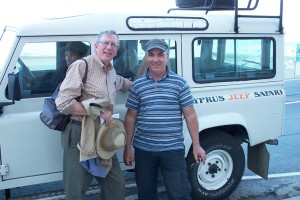 Turkish invasion. He was back to see the country under very different circumstances – a mirror of our own visit.
Turkish invasion. He was back to see the country under very different circumstances – a mirror of our own visit.
Sylvia was delighted to hear that our first stop was Lefkara, an old town in the foothills of the Troodos Mountains. I had always heard my mother talk about summer in the Troodos. The women and children of men employed by foreign companies or the British government escaped the lowland heat in the summers by moving to the mountains, where they lived in little tent villages. We had both treasured the old and exquisite lace tablecloth passed down to me from my grandmother many years ago. All I knew is that “it was from Cyprus.” It was Lefkara lace, or Lefkaritiko, the highest achievement of Cypriot folk art. The old craft was dying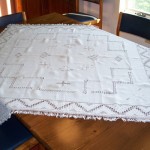 out as women turned from lacework to computers and urban lives. The government is subsidizing, through its handicraft programs, the recovery of this ancient art, which, we discovered later, reached its zenith about the time my mother was there. Indeed, the work was exquisite, along with delicate silver filigree work done by the men. Something that had been simply a special old tablecloth brought out on very special occasions now had its context, if not its specific story. It may have been bought in the marketplace. It may have been commissioned. We don’t know, but now we know what it was. We met hands descended from the hands that made our cloth.
out as women turned from lacework to computers and urban lives. The government is subsidizing, through its handicraft programs, the recovery of this ancient art, which, we discovered later, reached its zenith about the time my mother was there. Indeed, the work was exquisite, along with delicate silver filigree work done by the men. Something that had been simply a special old tablecloth brought out on very special occasions now had its context, if not its specific story. It may have been bought in the marketplace. It may have been commissioned. We don’t know, but now we know what it was. We met hands descended from the hands that made our cloth.
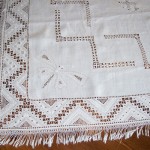 I brought out my old pictures in what would become a standard procedure at every stop. Andreas would show them to the old men gathered in the cafes and I would hear about families who had worked at the mine or who knew where a picture had been taken. We had a common connection in history and in this earth, this land. It was like the bond of copper and tin that had birthed the Bronze Age.
I brought out my old pictures in what would become a standard procedure at every stop. Andreas would show them to the old men gathered in the cafes and I would hear about families who had worked at the mine or who knew where a picture had been taken. We had a common connection in history and in this earth, this land. It was like the bond of copper and tin that had birthed the Bronze Age.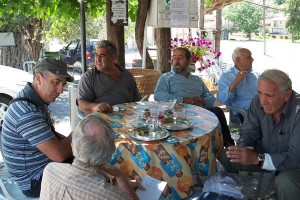
A few more miles higher into the mountains brought us to a little place called Mesapotamus, “between the rivers.” As we walked up to the falls among the tall fir trees I could feel hear my mother laughing and skipping to put her hands in the cold water, echoes of the picture in the album entitled “On the Way to Mesapotamus.” Fortunately, all this area is now a state preserve. They don’t even log here, lest the disturbance to the soil create erosion and flooding in a land where water is precious and trees are few, though they once covered the whole island.
We then dug into a four-wheel track (what my mother had traversed on a horse) over the ridge to Pano Platres, where Andreas took us to a quaint restaurant next to a trout farm. Guess what I had! Delicious. After 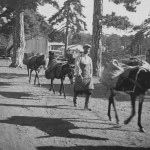 lunch we wove our way higher toward Mt. Olympus, at around 6,000 feet the highest peak in Cyprus. On the way we came to Troodos Square, which, Andreas showed me, was the exact place of
lunch we wove our way higher toward Mt. Olympus, at around 6,000 feet the highest peak in Cyprus. On the way we came to Troodos Square, which, Andreas showed me, was the exact place of 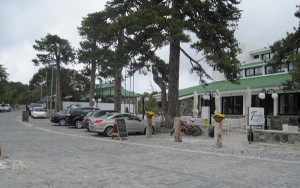 one of mother’s photographs. The donkeys and the men must have been descended from the picture. The trees were probably the same, only ninety years older. Only a new hotel changed the picture.
one of mother’s photographs. The donkeys and the men must have been descended from the picture. The trees were probably the same, only ninety years older. Only a new hotel changed the picture.
You can’t get to the top of Mt. Olympus. It is ringed with radar domes and microwave relay towers guarded by British and UN troops. We turned around under the glower of a bored guard.
The Troodos Mountains are home to dozens of old monasteries and churches, most with icons, frescoes, and mosaics. We visited a small, new roadside chapel (“Church of the Holy Cross”) with beautiful paintings all over its walls and ceiling. Outside was a small garden and a stunning view of the picturesque town of 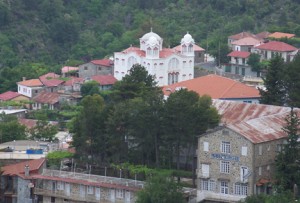 Pedoulas. The prize, however, is the Monastery of Kykkos, long the largest and wealthiest on the island. While it jealously and proudly houses an icon of the Virgin supposedly painted by St. Luke (a legend on Malta as well), what overwhelms the eye are the dozens of large mosaics done in the last thirty years that adorn the walls of the galleried courtyard. While I sometimes have the knee-jerk response of Judas (“This money could have been given to the poor.”), I was also being fed by the powerful images and sheer craft of this art, each one a biblical story or figure from Christian history. But at this point we were tourists, not pilgrims. Indeed, we had to skip the extensive museum housed in the monastery, another invitation to a future visit!
Pedoulas. The prize, however, is the Monastery of Kykkos, long the largest and wealthiest on the island. While it jealously and proudly houses an icon of the Virgin supposedly painted by St. Luke (a legend on Malta as well), what overwhelms the eye are the dozens of large mosaics done in the last thirty years that adorn the walls of the galleried courtyard. While I sometimes have the knee-jerk response of Judas (“This money could have been given to the poor.”), I was also being fed by the powerful images and sheer craft of this art, each one a biblical story or figure from Christian history. But at this point we were tourists, not pilgrims. Indeed, we had to skip the extensive museum housed in the monastery, another invitation to a future visit!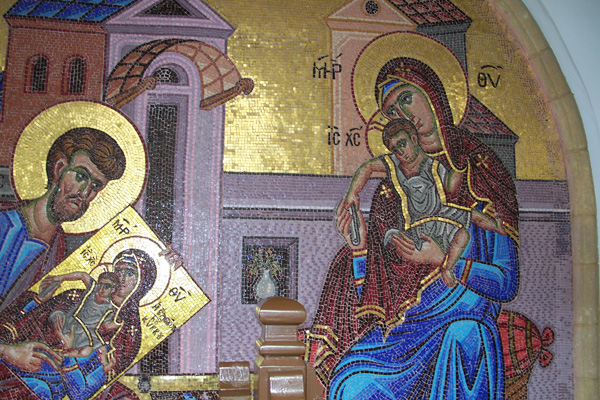
We descended the mountain to find that we were on the road to Skouriotissa itself. Indeed, we passed close enough to see the mine, a gash in the earth to the north. Stan remembered that the Green Line separating north and south had been drawn so that the mine would be on the Greek side, but the access to the sea was in the buffer zone. As we discovered later, this has not deterred the current developer, who overcame this logistical roadblock with state-of-the-art technology.
As we rode back to Larnaca on the four-lane (you can cross the island in a couple of hours) we had time to reflect on the conjunction of generations in my life and in the people we had met, the places we had seen. The geography, the trees, the people, the mine itself were like a medieval palimpsest on which we were writing yet another chapter.
We would come back to Skouriotissa on Monday, but first we were scheduled to visit the southeast coast, home of some of the most extensive Greek and Roman ruins on the island.

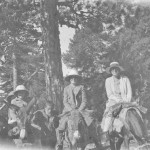
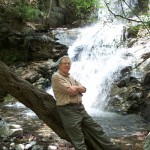
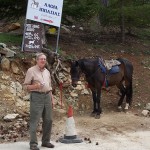
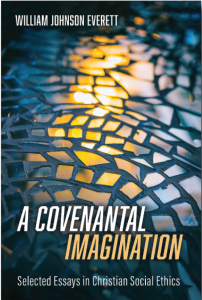
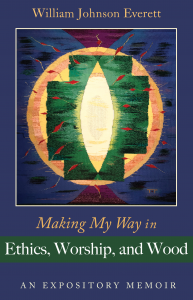
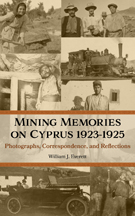

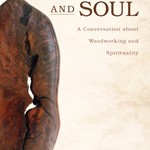
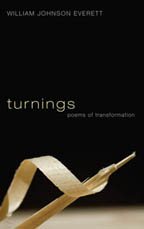
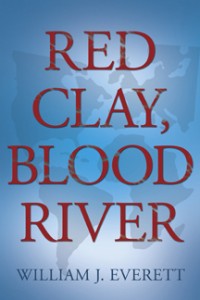 Red Clay, Blood River
Red Clay, Blood River
A friend who used to live in my Dorset village now lives in Cyprus and sent me the Cyprus Mail article on your trip back to Skouriotissa!! I lived there in 1945 as 9 YR OLD, mY pA WHO WORKED FOR cmc IN 1933/34 WAS OFFERED HIS OLD JOPB BACK AFTER ww2 SO WE CAME UP FROM s. afRICA. tHE PICTURE OF THE CHCURCH AND LITTLE MONASTRY was where We lived, butg o n the LH side of your photo!. I have since read your blog and loved all the memories it brought back.. I went back last Oct, the first visit in 30 yrs but to the NORTH Kyrenia,so couldn’t get to visit Skouriotissa which I had wanted to! Gosh the place has changed! I lived there until 1958 and then went back on holiday as my mother was still living there until 1973 and the Turkish Intervention!!(NOT Invasion). What fun this new computer world can be.!! Go back to the North, it is a LITTLE less spoiled!, but not much!! yours sincerely Christine Corson, Stoke Abbott Dorset DT8 3JZUK
Remind me of the connection your grandparents had to Cypress. Thanks for the great reports.
Thanks, Bill, for a travel logue of sorts and for your appreciation of the blending of past and present on that amazing island. So much ancient history there and you’ve shared the feeling of stepping back into time.
Thanks once again for a great account of your travels.